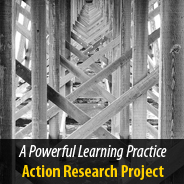Our school enrolls students from ages 3 to 18 across three divisions. Our PLP cohort comprises teachers from all three divisions and from a variety of subject areas. It was very difficult for us to formulate an action research topic that centered on a school-wide issue that related to all three divisions. But even as we struggled to find a common, overarching topic to research, each member of the cohort continued to tread new technological ground and to creatively utilize technology in his or her classroom. Our monthly PLP meetings were a productive time; we discussed different technologies, enjoyed cross-divisional, cross-grade and cross-curricular discussions, and helped vet each other’s pedagogical approaches. Finally, we realized that we all wanted more time to savor the process of watching each other teach and helping each other experiment with new, meaningful technologies in our classrooms. Therefore, we propose using the Critical Friends model as a supportive venue for our work next year. We hope this will enable each teacher to pursue his or her own curricular goals that are met or enhanced by 21st century technologies.
Objectives:
- To continue our cohort as a network of Critical Friends
- To develop forward-thinking, technology-based projects that are relevant to our specific curricula and age groups.
- To develop a culture of reflective, supported practice that will help enhance our collective knowledge of new technologies and pedagogical practices that support the use of those technologies.
- To find a manageable, meaningful way to spread the word about our discoveries. Perhaps this could be a blog where we share our reflections and discoveries with the community. We believe that this would be a more relatable — and potentially interactive — way to reach out to the faculty than a presentation at the end of the year. Additionally, we hope to make ourselves available for informal discussions at smaller gatherings, like department meetings.
Assessment:
- Each of us will have specific goals for what we hope to achieve. The extent to which we are successful as a cohort of Critical Friends will, in a sense, be measured by how well each group member feels supported and encouraged to meet his or her classroom goals.
- Each teacher will have his or her own means of assessing the success of his or her endeavors.
Summer – Read The Shallows: What the Internet is Doing to our Brains and perhaps a counterpoint to this book, like the classic Campfires in Cyberspace; continue exploring Web 2.0 technologies on our own; form our goals for the year.
September – Receive training in the Critical Friends method. Barbara Caldwell is already looking into this; decide how we will spread the word about our work in a manageable, meaningful way during the year? A blog? Discuss and address hurdles that might stand in the way of us meeting our goals, like helping administrators understand what we’re doing.
October – Meet and share goals for the year; plan one session per teacher to be observed by as many members of the cohort as can attend; teach the classes and be observed so that we can meet right before Thanksgiving.
November – Meet just before Thanksgiving; process the observations and offer feedback using the Critical Friends model
December – Touch base to review progress towards our goals.
January – Working day; meet for part of the day to reconnect
February – Another round of observations
March – Process observations
April – Reflect on the year, whether we met our goals; reflect on how well the Critical Friends model allowed us to meet our curricular goals and to grow as teachers and as colleagues; discuss the impact of our group on the larger community – did it have an effect?
May – Luncheon; discuss next steps, whether we’ll continue next year, etc.
This year, we learned that we want to take more time with the classroom observations and feedback; because of the makeup of our school, a global action research project is difficult to undertake, whereas a model that allows for individuality and flexibility from the different constituencies will produce a more relevant result.
We hope to build upon the individual successes that we’ve had in our classrooms this year. Additionally, because of the structure of the PLP program, we learned that having release time at least once a month is both do-able and helpful. Next year, we hope to learn even more about how to use technology effectively in the classroom.
Each person in our cohort will use our shared page in Moodle to share any artifacts/documents from this year that relate to our goals for next year.



excellent issues altogether, you just gained a new reader. What would you recommend about your publish that you made a few days ago? Any sure?
In case if you are starter to domain names registration then you are certainly a Domainbie